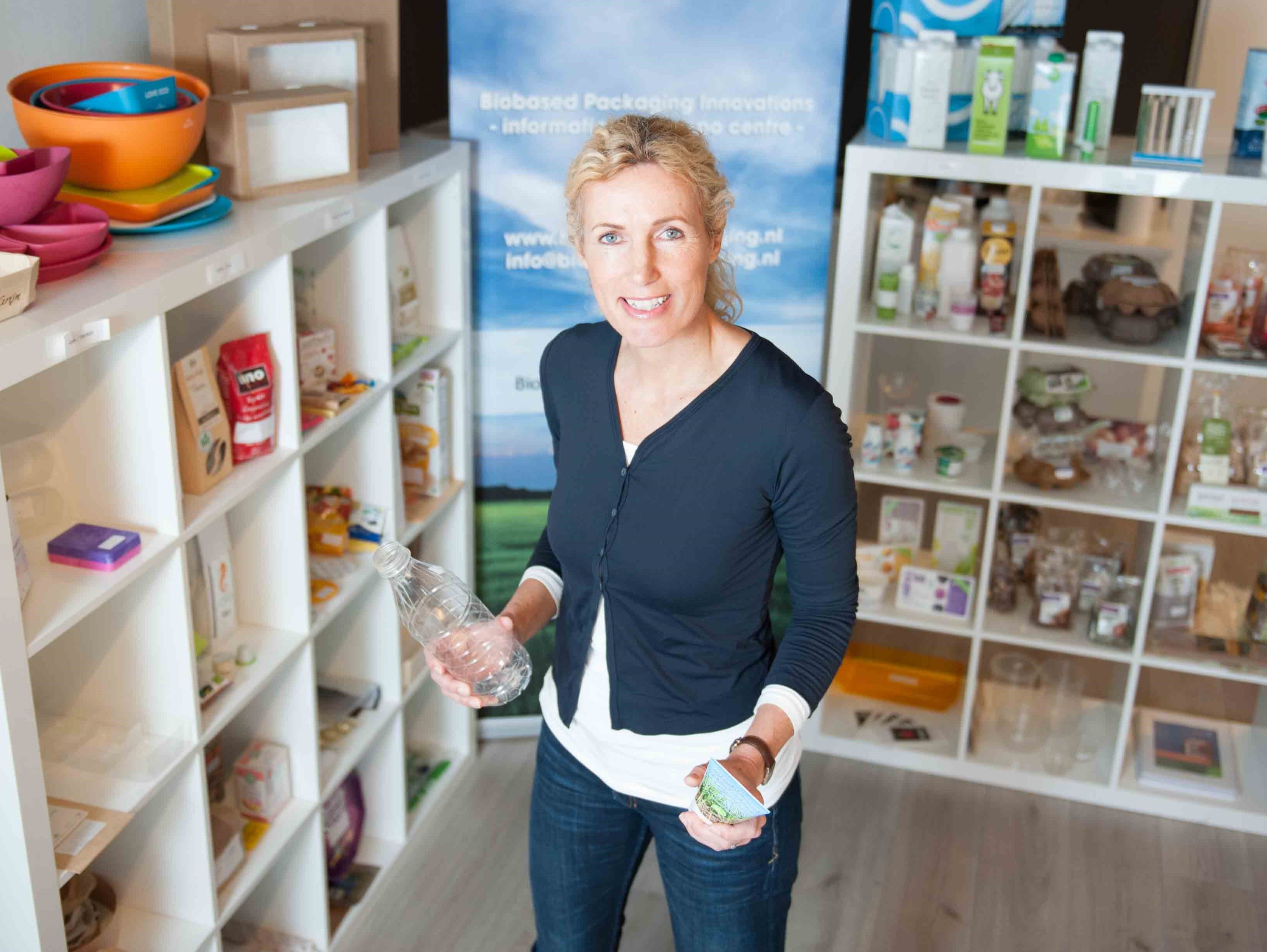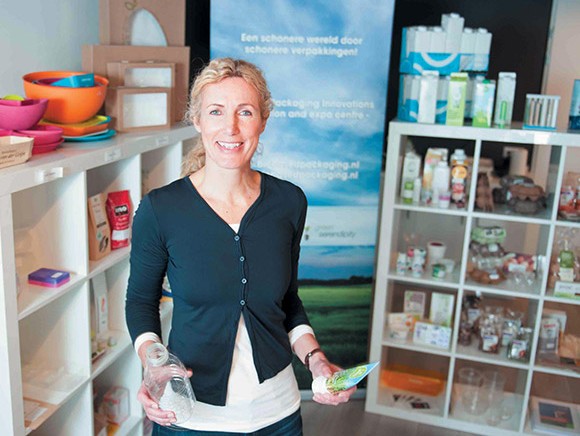
An economy that uses renewable sources, waste flows and waste materials from agriculture and the food industry to produce materials and energy: the ‘biobased economy’ holds the key to the future and represents opportunities for companies. Caroli Buitenhuis (packaging expert and Chain Manager Bioplastics and Biobased Packaging at InnovatieLink) is bursting with knowledge, ideas and contacts related to the topic.
The biobased economy is still in the very early stages of development but it has high expectations to live up to: ‘biobased’ will play an increasingly important role in the circular economy in the coming years. The Dutch government wants the biobased economy to evolve into one of the main pillars of the nation’s economy. To achieve that goal, and also to improve the opportunities for innovation in two of the country’s ‘top sectors’, chemicals and energy, InnovatieLink was founded by the Ministry of Economic Affairs in mid-2015. Caroli Buitenhuis works for one and a half days a week as Innovation Manager Biobased at InnovatieLink. In addition, she is connected to ‘Holland Bioplastics’. During the Empack packaging event (from 12-14 April in Utrecht) she will be telling visitors about the most important aspects of biobased packaging – both fact and fiction. She is also the organiser and moderator of the mini conferences on biobased packaging that are being held on the Tuesday and Wednesday of the trade show.
“From within InnovatieLink I advise SMEs on their innovation issues, with a particular focus on the development of bioplastics and biobased packaging materials. I answer questions from the industry, connect companies with one another and help them with bioplastics-related innovations. Packaging will always be necessary, and that includes plastic packaging. After all, plastics offer a lot of benefits especially for food applications: they are lighter than many other materials, have good barrier properties which is important in terms of food safety and shelf life, for example, and they protect the products during transport. But if we want to continue using plastic then we must think carefully about how we can do so as consciously as possible, i.e. with minimal use of natural resources and with respect for society and the environment. We all want to be able to swim in clean oceans, breathe clean air and go for walks in clean forests.”
“Bioplastic is a whole new industry and there’s a lot going on. Currently, bioplastics are mainly produced from maize, sugar beet and sugarcane, but the second generation of bioplastics will have a much greater component of by-products, waste flows and waste materials. Think of the maize stalks that can be used as a raw material, for example, or the wastewater from paper recycling – that contains lots of cellulose fibres, which are an excellent basis for bioplastic. One nice example is bioplastic made from the wastewater from a French fries factory. The water contains a lot of starch, which is another good basis. Mars has recently used that material to develop a new type of packaging.”
“Biobased packaging has to meet the same demands as any other type of packaging: quality is the top priority! If the packaging is used for food, then food safety and preserving the product quality are the most important criteria of course. Furthermore the packaging must be easy to use and safe to transport; the material must remain intact from the factory to the end user. The new materials offer significant advantages. For example, the biodegradable bioplastic PLA keeps pre-cut vegetables fresher for longer. Bioplastics have different properties and I expect that to result in major innovations in terms of new applications in the future.”
“Biodegradability requires precisely the right combination of temperature, humidity and microbes, but we don’t have those conditions in the Netherlands. Some bioplastics are only biodegradable in an industrial composting process, so they won’t biodegrade naturally but they can be disposed of in the green garden waste bin. They can also be processed via the plastic recycling route. Infrared light can be used to sort the bioplastic from the rest of the waste so that it can be fermented or recycled. Fermentation produces a lot of biogas and the remaining compost can be either reused to fertilise agricultural land or burned to generate renewable energy. The CO2 can be reclaimed and fed via pipes to nearby greenhouses to be used in plant production. So at the end of their useful life, bioplastics generate valuable biomass.”
‘It is absolutely essential to raise awareness of biobased plastics.’
“Anything is better than the current packaging materials. Nearly all packaging films currently on supermarket shelves comprise at least three layers, and a crisp bag even has nine layers. Multi-layer packaging can’t be recycled. At waste processing plants they can generally only use infrared to separate mono-materials from the rest. The aim is for all packaging to be either recyclable or compostable in the near future, but to achieve that we need to look at what has to be changed per packaging type. Each type of foodstuff places different demands on the packaging so it’s a huge task, but also an interesting and very enjoyable one!”
“Plants absorb carbon dioxide (CO2) from the air as they grow. Using this biomass to produce biobased plastics temporarily removes greenhouse gases (CO2) from the atmosphere. The duration of this carbon sequestration can be extended if the material is recycled or is returned to the soil as compost. Food packaging is often made from ‘virgin’ materials based on oil – a fossil fuel. Biobased plastics contribute to reducing the dependence on the planet’s limited fossil fuel resources. The oil price is very low at the moment but analysts predict considerable price fluctuations. For companies, those price differences form a risk factor for business continuity. One thing’s for sure: the price of oil will rise in the coming decades. There will come a tipping point in the future when oil becomes a more expensive natural resource than biobased materials. Companies are realising that they will have to prepare for that moment. A new packaging line is a huge investment so it’s useful if this is a step ahead of both the current opportunities and the future preferences and legal requirements.”
“An added bonus is that we can source the raw materials for a number of biobased plastics from within Europe, so bioplastics also contribute to the success of the European economy. The final waste can be processed locally or regionally. Much of the plastic that is currently recycled is sent abroad for processing, sometimes even as far afield as China. So processing biobased plastics entails less transportation and hence produces lower CO2 emissions.”
“It is absolutely essential to raise awareness of biobased plastics. At both Dutch and European level the government is focused on preserving natural resources and that’s a good thing. Awareness of the need to change continues to grow among companies and consumers alike, but that also requires access to the relevant knowledge. As Chain Manager Bioplastics I work together with bioplastics manufacturers and processors but also with governments and knowledge institutes to make that knowledge more accessible for the industry. We’ve already come a long way. Companies are realising that oil-based packaging will gradually have a negative impact on their image. Consumer resistance to the ever-larger mountain of plastic is growing and that is a motivator for companies to change. Processes like these don’t move quickly but they are underway.”
“Companies with questions can go to the websites hollandbioplastics.nl or biobasedpackaging.nl, which contain a lot of information, facts about bioplastics and answers to frequently asked questions. Furthermore, I’ve set up a ‘Bioplastics Info & Expo Hub’ in Amsterdam where I advise companies, without obligation, and help them to make the right choices about bioplastics or biobased packaging. I give them insight into the possibilities and which materials have already been tested for use with a particular type of product, and I put them in touch with the right producers and processors. I don’t decide for them, but I’ve learnt from experience that my help makes it easier for the companies to make sound decisions. And that’s what they need to do if we’re going to speed up the shift to sustainable packaging!”

How big is the bioplastics market right now – and how big will it become in the future?
According to the latest figures the global bioplastics production capacity is expected to grow by more than 350%, from around 1.7 million tons in 2014 to around 7.8 million tons in 2019. In addition, the European Commission has identified the bioplastics industry as one of the leading markets that can accelerate the growth of the circular economy in Europe. Major brands such as IKEA, Marks & Spencer, Coca Cola and Danone have all indicated that bioplastics-related developments are high on their corporate agendas. For example, Per Stoltz, Sustainability Developer at Ikea, recently said: “By 2020, 100% of our plastics will be made from renewable and recycled sources.”
Source: European Bioplastics
www.hollandbioplastics.nl
www.biobasedpackaging.nl
www.innovatielink.nl
Source: © InnovatieLink